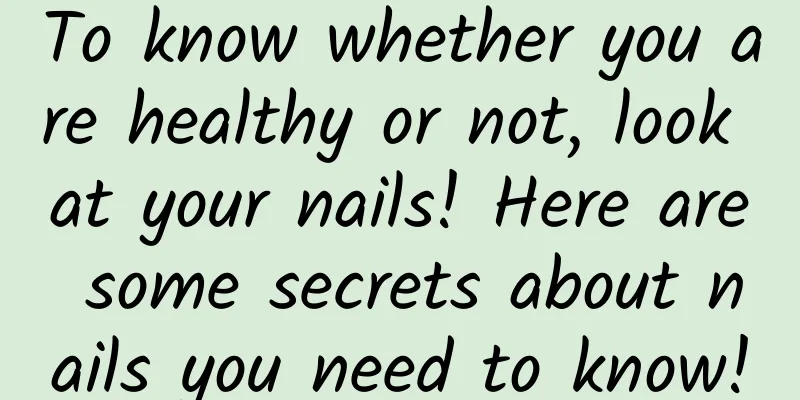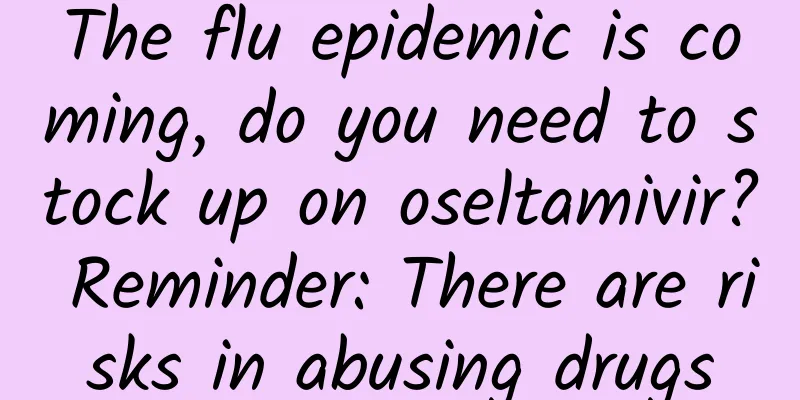To know whether you are healthy or not, look at your nails! Here are some secrets about nails you need to know!

|
I heard that you can tell whether your body is healthy by looking at your fingernails? What changes in nails may indicate a risk of disease? How should you cut your nails correctly? Which changes in nails should alert you to disease risks? Thin and soft nails The main component of nails is protein. If the nails are thin, soft, or even easily torn , it is likely a sign of malnutrition . Recommendation: Eat more protein-rich fish and shrimp , and you can also supplement trace elements that are beneficial to nail health, such as iron, potassium, zinc, etc. Nail loss If the nail falls off partially or completely, it may be an acute infection , especially in infants and young children, who may have hand, foot and mouth disease . Recommendation: Go to the hospital for treatment in time. Nail color changes Patients with lung disease are prone to clubbing and pale nails. Patients with liver disease have nails that turn yellow, and patients with kidney disease have nails that turn black. Recommendation: If you find that your nails have changed color, seek medical attention immediately. One or more black lines on the nail It can extend from the proximal end of the nail to the distal end. This may be a benign or malignant lesion caused by melanin deposition or melanocytes . If the black line gradually widens and exceeds 1/3 of the entire nail width, it should be taken seriously, indicating the risk of nail matrix melanoma . It is necessary to seek professional help and judgment from a doctor as soon as possible. Note: Nails without blood color may be a manifestation of anemia or other diseases such as fungal infection. Hollow, cracked, or vertical lines on your nails may be a sign of malnutrition or a lack of vitamins in the body. Nails become thickened, discolored, deformed, and dull It could be onychomycosis, a contagious fungal infection that occurs more often on toenails than on fingernails. Recommendation: Seek medical treatment promptly and take medication regularly, onychomycosis can be cured . Dark spots at the base of the nails The black spots are irregular and spread toward the nails. If they become wider and wider, there is a high possibility of malignant melanoma . Uneven nails A nail with pits on the surface, like the thimble of a sewing needle, is called a thimble nail. If this type of nail appears more frequently, it may indicate that psoriasis and eczema are in an active stage. Some misunderstandings about nails Myth: The more "lunulae" on your nails, the healthier you are. There is no necessary connection between the " crescent moon " and health. In fact, the newly grown nails are white, and the whiter the nails are, the newer they are. Then they slowly become transparent. Because the speed of new nails is different, faster in the middle and slower at the ends, they bulge out to form a "crescent", which is scientifically called "lunula". On the one hand, it can reflect the growth rate of the nails; on the other hand, it is also related to genetics and is different for each person. Only when the " crescent " changes suddenly, such as becoming bigger or smaller, can it be ruled out that there is a problem with health. Myth: White spots on nails are a sign of a serious illness White spots on the nails are called "punctate leukonychia" and generally have nothing to do with any disease. White spots are usually marks caused by minor problems when the nails are newly formed, or they may be caused by minor external injuries. Generally speaking, white nails do not need to be treated and will disappear on their own as the nails grow. Myth: The shorter your nails are, the better If the nails are cut too short, the skin around the nail will use its good elasticity to cover and wrap the end of the nail. As the nail continues to grow, the end edge will dig into the surrounding skin, causing the "ingrown nail" phenomenon. "Ingrown toenails" not only damage the skin tissue around the nail, but the damaged skin may also allow bacteria to enter and cause paronychia . Severe bacterial infection and suppuration may cause the bacteria to spread into the blood, and in rare cases may even cause systemic sepsis and be life-threatening . Therefore, if the symptoms of "ingrown toenails" are severe, with obvious pain, swelling, suppuration, or accompanied by paronychia, you should seek medical attention promptly and ask a professional dermatologist to treat it. How to trim nails scientifically? 1. Soak your hands or feet in warm water to soften your nails, which will help you control the strength when using nail clippers. 2. Trim the end of the nail into a straight line and keep it flush with the fingertips, retaining a length of about 1mm, and then slightly trim the left and right corners of the end of the nail. 3. Polish the sharp ends of nails to make their edges smooth. 4. The barbs on the hands should also be cut off at their roots with nail clippers to avoid skin damage caused by hand tearing. Source: Xinhuanet, Dingxiang Doctor, Healthy Guangdong |
<<: Can't help biting your nails? Beware of this disease
>>: Is it true that people who like spicy food are more likely to get hemorrhoids?
Recommend
The probability of Parkinson's disease in young and middle-aged people increases. Early diagnosis and treatment are the key
April 11th of each year is World Parkinson's ...
Why does my butt hurt after pregnancy?
After pregnancy, the hormones in the pregnant wom...
Mycoplasma vaginalis
The human body can be infected in many parts, and...
Is sandalwood harmful to women?
Many people know that sandalwood is a very good i...
Breast tenderness and scanty menstruation
Less menstrual flow and breast pain are common sy...
What causes breast cysts?
I believe that when I mention breast cysts, every...
Why do pregnant women urinate frequently at night?
During pregnancy, expectant mothers often want to...
Abdominal pain and no menstruation
It is normal for girls to experience dysmenorrhea...
What are the clinical manifestations of hydrosalpinx?
Hydrosalpinx is a relatively common female diseas...
World Leprosy Day丨Preventable, curable and not scary!
January 29, 2023 The 70th World Leprosy Day The 3...
Why do I always have brown discharge?
Nowadays, many girls have abnormal leucorrhea, an...
Relationship between fetal heart, fetal bud and yolk sac
After becoming pregnant, every pregnant mother ho...
What to do if breast suppuration
Women's breasts are particularly sensitive an...
Don't squeeze a pinhole! Here's how to deal with it correctly
Eyes are the windows to the soul and one of the m...
What to do if bleeding occurs after leep knife surgery
Leeknife surgery is a relatively popular treatmen...









